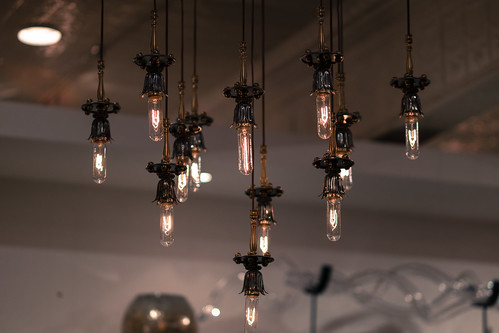Bottoms up: How fast should you finish that bottle of whiskey?
In recent years, we’ve found the term “industrial chic” to be a telling turn of phrase - seemingly oxymoronic at first, and exemplary of the times. The two terms were, for generations, rarely uttered in the same breath. In the last decade, though, as developers have repurposed once-utilitarian factories into event halls and evening venues, they’ve chosen to preserve the features that builders originally included purely for efficiency purposes — like large windows “so that work floors could be flooded with natural light” before the advent of the electric light bulb.
Peeling paint? Keep it. A cracked and speckled concrete floor? Polish it and let its beauty shine. Rusting iron fixtures? Let them add character to events’ photos.
The Edison bulb is emblematic of the "industrial chic" aesthetic.
In the world of whiskey, you can see a derivative of this mentality in the focus on both age statements and spirits from mothballed distilleries like Port Ellen and Pappy Van Winkle.
In a word, today’s thirsty whiskey enthusiasts crave the same intangible as modern event-planners and soiree-hosts: authenticity.
Over the months, we’ve chatted with more than a handful of whiskey drinkers who, in a quest to preserve their prized bottles of whiskey as long as possible, ask whether whiskey can go bad — or the converse, whether whiskey get better in the bottle? We thought we should weigh in.
The theoretical dram who lives forever
As high as whiskey’s proof is, a well-sealed, unopened bottle of whiskey can last in its distiller-perfected state for decades if kept out of direct sunlight.
Even once opened, whiskey’s high proof renders it immune from most contaminants that render less stout beverages like milk and wine undrinkable a number of days after you’ve opened them. In other words, whiskey does not “go bad” in a traditional sense, even after you open the bottle.
However, as we’re all aware, whiskey is a social lubricant. As a volatile compound, it likes to interact with both its environment and the molecules in its vicinity. But these interactions are not always optimal. For example, ultraviolet light from direct sun exposure degrades the tannins that whiskey absorbs from spending time in oak.(1) Storage temperatures higher than around 70 degrees Fahrenheit likewise result in no good to whiskey. Perhaps the most transformative interaction, though, is whiskey’s tango with air.
Every time you open a bottle and pour a dram, you both raise the ratio of oxygen to whiskey in the bottle and allow the spirit and all its various compounds to mix with air.
Although oxygen is like the Lassie of elements to humans, it interacts with whiskey more like a frenemy. As the level of whisky in a bottle subsides in a delicious tide of Manhattans and neat pours, more oxygen fills the empty space in the bottle. The oxygen in the bottle reacts with a number of different compounds in the whiskey. Eventually, the oxygen succeeds in decreasing certain esters — or flavor compounds — of the whiskey, chiefly in the citrus and fruit categories. (Some refer to this as “oxidation”, similar to how rust forms in our repurposed industrial space from earlier, although this is not an entirely accurate statement.(2))
Unlike fruity esters that diminish over time, the phenol group vanillin increases in a bottle as time passes, yielding more vanilla notes. And in what must certainly qualify as the nerdiest of all reactions, oak lactones present in the whiskey due to its prior life in a cask (or a barrel) transform from spicy, incense-like aromas to coconut and vanilla aromas over time.(3)
To some who like more delicate drams, these changes in the bottle are a windfall. For others more interested in the wood and spice elements of whiskey, these are nothing short of a crestfall, somewhat like the notorious September Collapse of the 2011 Atlanta Braves.
The Ted in 2013. Starting 2017, the Braves will reside in a new park
Even more drastically, in the case of a faulty or improperly re-inserted cork, the whiskey can lose significant amounts of ethanol to evaporation. The result is a weaker and significantly less drinkable dram, like harsh brown water.
Whiskey consumption-speed guide
In light of this, we’ve put together a helpful guide for how quickly to consume your whiskey:
Unopened bottle — in 10 years (because an unopened bottle of whiskey is a universal tragedy)
Freshly opened bottle — in 2–3 years
Half-full bottle — in 1–2 years
Attempts to extend a bottle’s lifespan
Sometimes, it’s not quite practical to finish off a quarter bottle of whiskey in the recommended 3 month timeframe from above. In this case, fear not: you can preserve your whiskey by transferring it to a smaller bottle, one that provides as little headspace as possible between the level of the whiskey and the cork or screw cap.
As one final note in this quest to find the fountain of youth for whiskey, some drammers, in a bid to preserve whiskey like the best of oenophiles, take to storing a bottle of whiskey on its side. Unlike with wine, though, such a practice only ends in further distress for the dram-seeker. Because when you store whiskey on its side, the high-proof ethanol slowly erodes the cork — a flavor that doesn’t show up on a standard tasting wheel because it’s more or less gross.
All in all, once you open your prized bottle of Pappy, understand that the clock begins ticking. While in the short-term, the whiskey may take on favorable characteristics like an increased presence of vanilla, whiskey is ultimately a fickle minstrel, prone to losing its touch just as easily as it brought a smile to your lips. Consume it regularly, and it will always reward you. And in those rare instances where you face the imminent degradation of your dram, always feel free to invite over a merry band of pranksters to help you finish off the bottle. There are plenty more authentic brands on the shelves of your local liquor store taking a page from industrial spaces the world over and waiting patiently for your attention.
— — — — —
(1) A similar reason explains beer companies’ overwhelming choice of green and brown for bottles.
(2) “The interaction of [whiskey] with air is commonly called oxidation. This is a bit of a misconception because [whiskey] is not a homogenuous material like iron that can rust. It is a very complex mixture of many chemicals, some of which actually do oxidize and some of which are inert to the influence of oxygen.” http://www.dramming.com/2010/03/21/does-whisky-age-in-a-bottle/
(3) For all you AMC characters with the pseudonym Heisenberg, this is a conversion from trans-isomers to cis-isomers.


